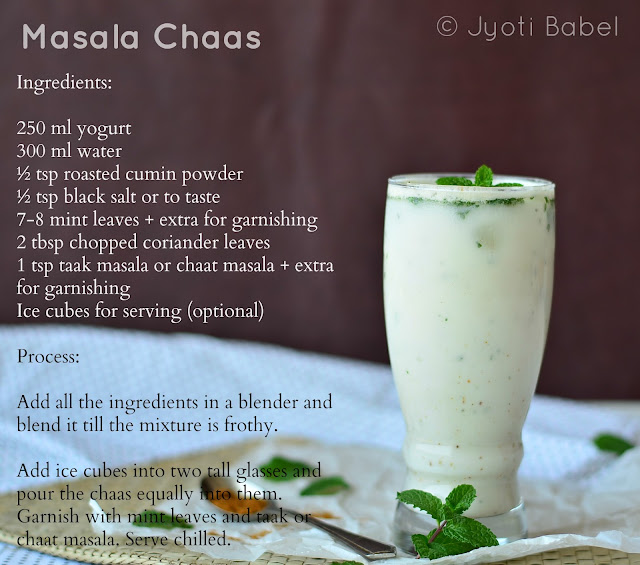 |
| Masala Chaas #Recipe |
Masala Chaas is a yogurt based drink. It is yummy and it is very good for health in summer months. It helps to cool the body, aids in digestion and keeps you hydrated. The best thing about it is that it is so simple to make it – just get all the ingredients and blend it and it is ready to be gulped down.
This time of the year is the time to indulge in some cool drinks and I am doing just that. Past few days, I am guzzling down large glassfuls of ‘Masala Chaas’ or ‘Masala Taak’ as it is called in Maharashtra.
The last week of March 2017 has seen mercury rising steeply here in Pune. The heat is relentless; one look outside the window in the afternoon will make your eyes squint and make your head dizzy. Forget about stepping out in the sun – else the menacing rays of sun with scorch your body.
Such is the heat that I keep all the curtains drawn in all the rooms; the fans are doing overtime running at full speed all the time. When things look unmanageable, the air conditioner also steps in. Apart from keeping the house cool, it is also important to keep our bodies cool and hydrated. Drinking lots of water and fluids is very important and they are the only things that are keeping me sane in this hot weather.
Looking for more summer drink ideas – check out Sweet Lime Soda, Ginger Mint Lemonade, Makhanya Lassi, Blueberry Lemonade or Strawberry Lemonade
How to Make Masala Chaas| Simple Masala Chaas Recipe
Ingredients:
250 ml yogurt
300 ml water
½ tsp roasted cumin powder
½ tsp black salt or to taste
7-8 mint leaves + extra for garnishing
2 tbsp chopped coriander leaves
1 tsp taak masala or chaat masala + extra for garnishing
Ice cubes for serving (optional)
Process:
1. Add all the ingredients in a blender and blend it till the mixture is frothy.
2. Add ice cubes into two tall glasses and pour the Chaas equally into them. Garnish with mint leaves and taak or chaat masala. Serve Chilled.
Notes:
1. This yogurt based drink is common all across India. However, some regions have their own simple variations. Some common variations are adding a green chili for some spice or ginger, asafoetida (hing), curry leaves and black pepper. All of these helps in digestion.
2. I have used store bought taak masala. But it can be easily substituted with chaat masala.
What cool drinks you are indulging in to beat the heat? Do share.
Thank you for stopping by! Cheers!












